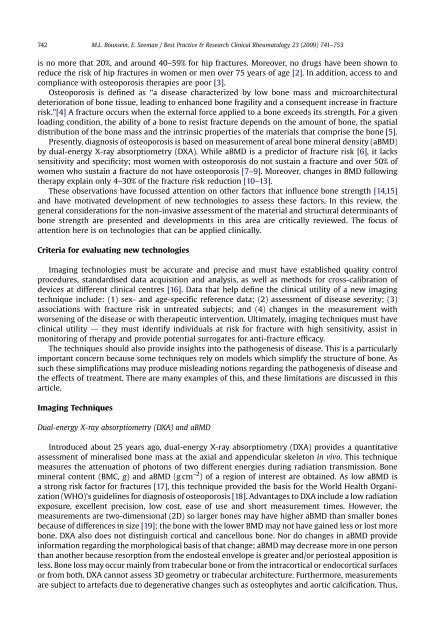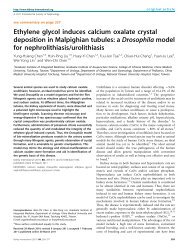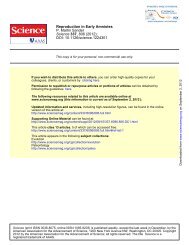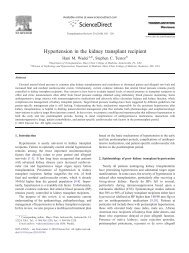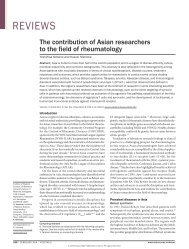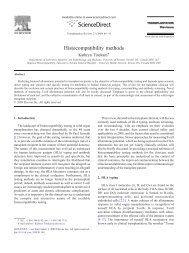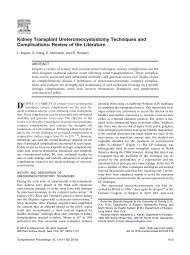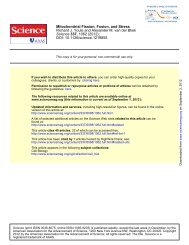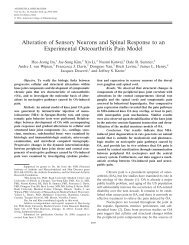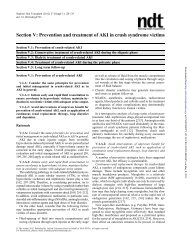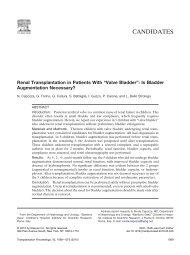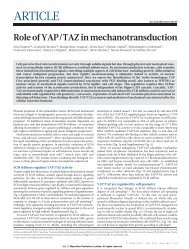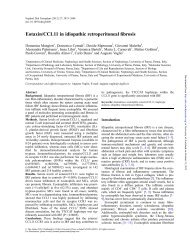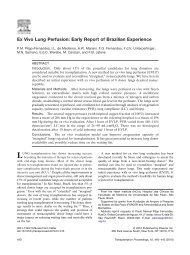Quantifying the material and structural determinants of bone strength
Quantifying the material and structural determinants of bone strength
Quantifying the material and structural determinants of bone strength
You also want an ePaper? Increase the reach of your titles
YUMPU automatically turns print PDFs into web optimized ePapers that Google loves.
742<br />
is no more that 20%, <strong>and</strong> around 40–59% for hip fractures. Moreover, no drugs have been shown to<br />
reduce <strong>the</strong> risk <strong>of</strong> hip fractures in women or men over 75 years <strong>of</strong> age [2]. In addition, access to <strong>and</strong><br />
compliance with osteoporosis <strong>the</strong>rapies are poor [3].<br />
Osteoporosis is defined as ‘‘a disease characterized by low <strong>bone</strong> mass <strong>and</strong> microarchitectural<br />
deterioration <strong>of</strong> <strong>bone</strong> tissue, leading to enhanced <strong>bone</strong> fragility <strong>and</strong> a consequent increase in fracture<br />
risk.’’[4] A fracture occurs when <strong>the</strong> external force applied to a <strong>bone</strong> exceeds its <strong>strength</strong>. For a given<br />
loading condition, <strong>the</strong> ability <strong>of</strong> a <strong>bone</strong> to resist fracture depends on <strong>the</strong> amount <strong>of</strong> <strong>bone</strong>, <strong>the</strong> spatial<br />
distribution <strong>of</strong> <strong>the</strong> <strong>bone</strong> mass <strong>and</strong> <strong>the</strong> intrinsic properties <strong>of</strong> <strong>the</strong> <strong>material</strong>s that comprise <strong>the</strong> <strong>bone</strong> [5].<br />
Presently, diagnosis <strong>of</strong> osteoporosis is based on measurement <strong>of</strong> areal <strong>bone</strong> mineral density (aBMD)<br />
by dual-energy X-ray absorptiometry (DXA). While aBMD is a predictor <strong>of</strong> fracture risk [6], it lacks<br />
sensitivity <strong>and</strong> specificity; most women with osteoporosis do not sustain a fracture <strong>and</strong> over 50% <strong>of</strong><br />
women who sustain a fracture do not have osteoporosis [7–9]. Moreover, changes in BMD following<br />
<strong>the</strong>rapy explain only 4–30% <strong>of</strong> <strong>the</strong> fracture risk reduction [10–13].<br />
These observations have focussed attention on o<strong>the</strong>r factors that influence <strong>bone</strong> <strong>strength</strong> [14,15]<br />
<strong>and</strong> have motivated development <strong>of</strong> new technologies to assess <strong>the</strong>se factors. In this review, <strong>the</strong><br />
general considerations for <strong>the</strong> non-invasive assessment <strong>of</strong> <strong>the</strong> <strong>material</strong> <strong>and</strong> <strong>structural</strong> <strong>determinants</strong> <strong>of</strong><br />
<strong>bone</strong> <strong>strength</strong> are presented <strong>and</strong> developments in this area are critically reviewed. The focus <strong>of</strong><br />
attention here is on technologies that can be applied clinically.<br />
Criteria for evaluating new technologies<br />
Imaging technologies must be accurate <strong>and</strong> precise <strong>and</strong> must have established quality control<br />
procedures, st<strong>and</strong>ardised data acquisition <strong>and</strong> analysis, as well as methods for cross-calibration <strong>of</strong><br />
devices at different clinical centres [16]. Data that help define <strong>the</strong> clinical utility <strong>of</strong> a new imaging<br />
technique include: (1) sex- <strong>and</strong> age-specific reference data; (2) assessment <strong>of</strong> disease severity; (3)<br />
associations with fracture risk in untreated subjects; <strong>and</strong> (4) changes in <strong>the</strong> measurement with<br />
worsening <strong>of</strong> <strong>the</strong> disease or with <strong>the</strong>rapeutic intervention. Ultimately, imaging techniques must have<br />
clinical utility d <strong>the</strong>y must identify individuals at risk for fracture with high sensitivity, assist in<br />
monitoring <strong>of</strong> <strong>the</strong>rapy <strong>and</strong> provide potential surrogates for anti-fracture efficacy.<br />
The techniques should also provide insights into <strong>the</strong> pathogenesis <strong>of</strong> disease. This is a particularly<br />
important concern because some techniques rely on models which simplify <strong>the</strong> structure <strong>of</strong> <strong>bone</strong>. As<br />
such <strong>the</strong>se simplifications may produce misleading notions regarding <strong>the</strong> pathogenesis <strong>of</strong> disease <strong>and</strong><br />
<strong>the</strong> effects <strong>of</strong> treatment. There are many examples <strong>of</strong> this, <strong>and</strong> <strong>the</strong>se limitations are discussed in this<br />
article.<br />
Imaging Techniques<br />
M.L. Bouxsein, E. Seeman / Best Practice & Research Clinical Rheumatology 23 (2009) 741–753<br />
Dual-energy X-ray absorptiometry (DXA) <strong>and</strong> aBMD<br />
Introduced about 25 years ago, dual-energy X-ray absorptiometry (DXA) provides a quantitative<br />
assessment <strong>of</strong> mineralised <strong>bone</strong> mass at <strong>the</strong> axial <strong>and</strong> appendicular skeleton in vivo. This technique<br />
measures <strong>the</strong> attenuation <strong>of</strong> photons <strong>of</strong> two different energies during radiation transmission. Bone<br />
mineral content (BMC, g) <strong>and</strong> aBMD (g cm –2 ) <strong>of</strong> a region <strong>of</strong> interest are obtained. As low aBMD is<br />
a strong risk factor for fractures [17], this technique provided <strong>the</strong> basis for <strong>the</strong> World Health Organization<br />
(WHO)’s guidelines for diagnosis <strong>of</strong> osteoporosis [18]. Advantages to DXA include a low radiation<br />
exposure, excellent precision, low cost, ease <strong>of</strong> use <strong>and</strong> short measurement times. However, <strong>the</strong><br />
measurements are two-dimensional (2D) so larger <strong>bone</strong>s may have higher aBMD than smaller <strong>bone</strong>s<br />
because <strong>of</strong> differences in size [19]; <strong>the</strong> <strong>bone</strong> with <strong>the</strong> lower BMD may not have gained less or lost more<br />
<strong>bone</strong>. DXA also does not distinguish cortical <strong>and</strong> cancellous <strong>bone</strong>. Nor do changes in aBMD provide<br />
information regarding <strong>the</strong> morphological basis <strong>of</strong> that change; aBMD may decrease more in one person<br />
than ano<strong>the</strong>r because resorption from <strong>the</strong> endosteal envelope is greater <strong>and</strong>/or periosteal apposition is<br />
less. Bone loss may occur mainly from trabecular <strong>bone</strong> or from <strong>the</strong> intracortical or endocortical surfaces<br />
or from both. DXA cannot assess 3D geometry or trabecular architecture. Fur<strong>the</strong>rmore, measurements<br />
are subject to artefacts due to degenerative changes such as osteophytes <strong>and</strong> aortic calcification. Thus,


